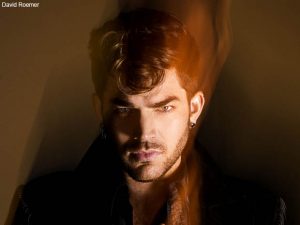
NATIONAL POST
25 June by Russ Martin
On the heels of his last album, Adam Lambert was staring into the commercial abyss. Trespassing, released in 2012, marked Lambert’s first number one album, and the first Billboard number one debut for an openly gay artist, but sales waned quickly and soon there was trouble with his label, RCA. The company asked for an album of 80s covers, but Lambert wasn’t interested. He decided to walk. For the first time since his second place showing on American Idol in 2009, Lambert was confronted with the very real possibility his career was hitting a wall. That he was about to fade away like so many other Idol stars.
Seated on a couch on the second floor of Rivoli in Toronto a day after appearing at the Much Music Video Awards, Lambert recounts his fear leaving RCA. “When I decided to leave the last label, I had a moment of, ‘Well, I hope I didn’t just kiss my chances goodbye,’” he says.
The fear didn’t last long. The very next day Warner Bros offered Lambert a new deal, laying the groundwork for his third album, The Original High, released June 16. Recorded in Sweden, the album is guided by co-executive producers Max Martin and Shellback, the hitmakers behind Maroon 5’s “Moves Like Jagger,” Ariana Grande’s “Problem” and Taylor Swift’s blockbuster album 1989.
The Original High marks a departure for Lambert, both sonically and in terms of his image. The album’s more electronically driven than what he’s delivered in the past, borrowing from the early 90s house music like C + C Music Factory and Robin S. Lambert discovered as a teenager. It’s melancholic, mostly mid-tempo and much less than in your face than Trespassing or his debut, For Your Entertainment.
Lambert’s toned down the theatrics. Gone is the theatre kid rave drag he once presented: the jet black spiked hair, heavy makeup and elaborate costumes. At the Rivoli, he wears jeans and a black button up. The only classic Glambert detail is the sparkling black polish on his finger nails.
“Ten years ago, my favourite thing was to go out to a club wearing a crazy club kid outfit and tons of makeup and have a really, really wild night, including an after party or three,” Lambert says. Now, he says his needs have changed, both personally and professionally. “You go through different phases. In my last chapter, I was really, really expressing myself. Hardcore. Now I’m at a place where less is more.” Citing a discussion with recent friend Sam Smith, Lambert explains the marketplace for an out artist has evolved. “I was talking to Sam about how the post-gay thing is now an actuality. We’re moving towards a time where we don’t need to be defined only by our community or sexual orientation,” he says. “In some ways, the gay community is starting to become more open ended. Because we’re becoming more normalized and mainstream, the community isn’t as segregated and insular as it used to be.”
Part of Lambert’s transformation has undoubtedly been his career-shifting turn as the touring frontman of Queen. In 2014, the band set out on the road with Lambert filling in for the late Freddie Mercury to favourable reviews and sell out shows. (They have another string of dates set for South America this autumn.)
It was the injection of confidence Lambert had been looking for. “It put me in a different space in my career and my personal life. It definitely gave me a confidence boost and helped reframe me in the public.”
Performing with Queen, he realized he could leave the confines of the Adam Lambert brand and change his style as a performer. “Queen jumped genres like crazy. They’re the king of that,” he says. He pauses, realizes what he’s said, and rolls his eyes. “Or the queen of that.”
Though sonically different from Queen, The Original High provides Lambert the chance to genre hop himself, most notably on “Lucy,” which features Queen’s Brian May on guitar.
It has also brought some of the commercial success he was after. While the album’s first week sales were a modest 47,000 in the U.S., its first single, “Ghost Town,” is a top 40 hit that’s gaining on radio, fuelled in part by its video, which has more than six million views.
The video, directed by Hype Williams, is also proof the old, larger-than-life Lambert isn’t dead. While Williams streamlined Lambert’s theatrics into a crisp, hypnotic black and white video, its shoot sounds a bit like his club kid days in West Hollywood. To hear Lambert tell it, the two-day shoot was a margarita-fuelled party featuring a motley crew of friends and collaborators, including the makeup artist Sutan Amrull (better known as the drag queen Raja) and a group of dancers assembled by former Pussycat Doll Carmit Bachar.
“I still have my wild nights,” Lambert says.